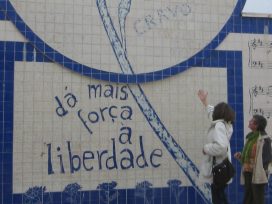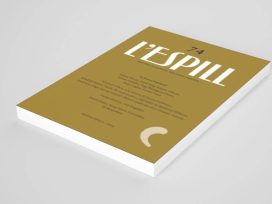The plot of Shakespeare’s “dark comedy” Measure for Measure begins with the capricious decision of the Viennese duke to abandon his throne for a while and leave it to his deputy, Angelo. Somewhat later, the duke explains the true reasons for this decision to his confidant, friar Thomas: “And he [Angelo] supposes me travell’d to Poland; for so I have strew’d it in the common ear, and so it is receiv’d.” But it is only a trick, since the duke remains in Vienna and, masked as a friar, observes what happens in the city during his supposed absence. Shakespeare thus uses the handy motif of a ruler who keeps his subjects in the belief that he is not there while watching them in secret.
“You will demand of me, why I do this,” says the duke to the surprized friar Thomas. “We have strict statutes and most biting laws, the needful bits and curbs to headstrong jades, which for these nineteen years we have let slip,” says the duke. Nobody bothers to obey them, since, as the duke further explains, “our decrees, dead to infliction, to themselves are dead, and Liberty plucks Justice by the nose.” In short, the city is infected by lawlessness and “quite athwart goes all decorum.” Thomas’ logical question of why the duke should not enforce the laws by himself, instead of delegating the task to Angelo, receives the following answer: “Sith ’twas my fault to give the people scope, ‘twould be my tyranny to strike and gall them for what I bid them do: for we bid this be done, when evil deeds have their permissive pass, and not the punishment.”
Thus, the duke uses a trick in order to establish such political relations in his state that will eventually bring him considerable benefit: people will come to their senses owing to the firm “legalistic” hand of the temporary sovereign, his deputy Angelo – who is literally the duke’s “angel” on the throne or, quoting the duke, “at full ourself” – and when the duke returns from his supposed journey, people will welcome him as their liberator and good father. Nobody will be able to criticize him as a tyrant, since it was someone else – in this case his deputy – who did all the dirty work and thus accomplished precisely what the duke wanted most: to “curb” the wanton people, who live too liberal a life, by strictly enforcing the most austere laws. For Angelo has been granted limitless power, which he can use at his own will, as we are informed in the very first scene: “Your scope is as my own, so to enforce or qualify the laws as to your soul seems good.”
To be sure, the duke does not ask Angelo to implement the existing legal regulations more rigorously. In the second scene, young poet Claudio, the first victim of the new regime, threatened with the death penalty for lechery – which is, from the perspective of modern penology, a disproportionally severe punishment for his sin against public morality – complains that Angelo has revived “all the enrolled penalties which have, like unscour’d armour, hung by th’ wall so long, that nineteen zodiacs have gone round, and none of them been worn.” In other words, the deputy has become more Catholic than the Pope: penalties that were only a potential threat to trespassers at the time of the ducal rule are now being carried out consistently – strictly “by the letter of the law,” as we call it. In this way, he has created the figure of the dissident from the very outset, a role that befell a young artist – almost expectedly, we might say – the excessively liberal (or perhaps merely frivolous) man of letters Claudio.
Shakespeare wrote at a time which historians have labelled the “early modern period,” that is, the time before the French Revolution, when power was still residing in the hands of an absolutist (more or less “enlightened”) ruler. If we compare that still “pre-modern” method of repressive subordination to the absolutist ruler with, let’s say, the ideological horizon of today’s late-capitalist society, we will soon notice that the contemporary neoliberal rulers use more subtle, yet equally efficient methods in establishing their ideological hegemony. Althusser has explained this mechanism through the concept of interpellation: “The individual is interpellated as a (free) subject in order that he shall submit freely to the commandments of the Subject, i.e. in order that he shall (freely) accept his subjection, i.e. in order that he shall make the gestures and actions of his subjection ‘all by himself’.” There are “no subjects except by and for their subjection” and therefore they “work all by themselves.” In short, with Althusser’s “good” (meaning subjected and obedient) subject the very ideological mechanism of interpellation is sufficient to make the interpellated subjects obedient to the authorities. The appeal of this mechanism is that it needs absolutely no repressive measures to create “tame” subjects; people will be subjected without even noticing that they have been subjected, believing it to be their own “free” decision. That famous “free choice” of the liberal-bourgeois subject is in essence a specific type of slavery, which is why some have called it “liberal slavery.” The basis of this modern slavery is the ideological construct of the “free subject,” who spontaneously experiences his subjection as freedom surplus.
And here we come to an important turn in the perception of Shakespeare’s play. In order to make Angelo consistently implement the dictatorship of law – and to pursue this dictatorship of the “rule of law” with an even greater zeal than he would if he were ordered to do so expressly – the duke offers him “free choice.” Thus, in Shakespeare’s play Vienna is an artificially (in vitro) produced situation after the French Revolution at the time before it happened. Besides, as early as 1604, when he wrote Measure for Measure, the master of Elizabethan drama anticipated concepts that would evolve only in the eighteenth century, such as “legal despotism” as discussed by the French physiocrats, or the rule of law as described by Immanuel Kant in his Metaphysics of Moral (1797). The duke’s explanation that he transferred the task of curbing the people to his deputy in order not to be reproached for being a tyrant is a rather transparent political scenario; in fact, the duke does exactly what he allegedly (declaratively) seeks to avoid – thereby using the ideological mechanisms on which the modern societies of free subjects and tame consumers are based. In short, both the duke’s moralizing pathos (improving the people with the help of law) and Angelo’s legal fetishism (blind faith in the power of law, the “rule of law”) seem to be Siamese twins that fatally determine the “oppressive” atmosphere of this “dark comedy”. The dictatorship of law probably cannot yield anything else but bitterness, and Measure for Measure is indeed anything else but a light comedy.
When mentioning the physiocrats and Kant in the previous passage, we have already moved away from the Elizabethan England of the early seventeenth century, and reached the second half of the eighteenth century, that is, pre-revolutionary France and Prussia at the time of Frederick the Great. “Enlightened absolutism” introduced new legal standards, which ushered a long era of legalism, the “cult of law.” In an attempt at gaining complete control over law as the (ideological) social bond, “the culture of economic liberalism equipped itself with the steel armour of authentic legal absolutism,” as the historian of European law, Paolo Grossi, has observed. The opposition between economic liberalism and legal absolutism is only an illusion, since it was already the early Enlightenment, with its “father of liberalism” John Locke preaching the “sanctity of private property”, and in order to secure its undisturbed accumulation and protection, the emerging bourgeoisie of the time needed a powerful state. The citizen, a politically free member of the bourgeois society, established relationships with his equal co-citizens in a civil society, and equality in that civil society was a precondition for inequality in the sphere of production. For the capitalist mode of production, it was characteristic that the owners of capital and those of labour met on the market as free contract parties – as legal subjects. Unlike Kant, who was still a prisoner of the conceptual imagery of feudal social relations, which is why in his work the subject was still not on the level of an abstract, self-sufficient monad, Hegel had already established the concept of a universal, equal subject. That universal and abstract subject has been a faithful companion of civil law since the late eighteenth century and has remained so until the present day. It is a product and also a condition of social production, which takes place on the basis of commodity exchange and waged labour, while its abstraction is, using a metaphor of Paolo Grossi’s, “an efficient fig leaf” concealing the injustice of the bourgeois society.
Legal state, equality, and immunity
The historical triumph of the capitalist mode of production over the feudal one was also the triumph of the principles of legal subjectivity. When this principle won and human relations became juridicized, that is, when they acquired the form of relations between legal subjects, the legal system evolved along with them, and it is precisely in capitalism that it reached its historically most developed version. A decisive role in the emergence of the legal subject of civil law was played by private property. The relationship between the owner of the means of production and the immediate producers supplies a historical and material basis for an analysis of differences between individual legal systems. The form of that relationship (in the capitalist mode of production, for example, it is exploitation) is the crucial line of differentiation, which eventually determines the socio-economic formation, as well as the corresponding legal system.
The political-legal equivalent of modern capitalism is the civil state, which is also called a legal state (Rechtsstaat), or the rule of law. One of the basic elements of the rule of law is equality before the law. The principle of equality before the law should guarantee the right to equal and non-discriminating legal security, along with the basic rights and freedoms as defined by the Constitution. However, despite that basic principle of the rule of law, modern legal systems grant special rights to certain social or professional groups. A classical illustration of that situation is, for example, the immunity protection of parliament members, who should in the framework of the political system of parliamentary democracy represent “the voice of the people” within the legislative branch of government. One of the earliest examples of specially protected representatives of public will in representative bodies were the popular tribunes (tribuni plebis) in ancient Rome, who were considered untouchable (sacrosancti). In today’s sense of the word, the immunity of representatives is linked specifically with the evolution of the legal system throughout the history of English parliamentarianism, where it was all about the crown and parliament competing for power. From the fourteenth century onwards, namely, it was no longer self-understandable that a representative should end in prison because he said something that did not quite suit the monarch.
Immunity is a sort of specific and specially protected, that is, privileged status, which can also be understood as exemption, that is, a sort of abolition of a general and universally valid rule, which the principle of equality certainly is (at least within the system of the rule of law). Equality is one of the central constitutional and legal principles as equality in the law and before the law, but is contradictory at the same time, since it leaves an open door for arbitrary and subjective judgment in those cases in which aberrations from this basic principle are legally “acceptable.” To be sure, the universal and abstract nature of modern law is a normative setting that guarantees, among other things, a consistent implementation of the principle of equality, yet as noted by Miro Cerar, “the abstract and general nature of law are not simply neutral legal techniques of a sort; instead, both of these properties of law have important ideological functions.” Besides, legal equality is “by its very nature formal equality, since owing to its very generality (and abstraction) it treats legal subjects and their activities in a typified manner, without taking into account numerous specific differences between them.” The principle of equality before the law (l’égalité devant la rÈgle de droit) means, if we simplify it to some extent, a consistent implementation of the regulations in administrative, juridical, and other legal practice, or to put it differently, the duty of these instances to “apply an adequate legal norm to a specific situation, thereby not allowing for any exceptions that are not foreseen by the law.” On the other hand, the principle of equality in the law (l’égalité devant la rÈgle de droit) demands from the legislator to respect the equality of all legal subjects, which actually does not compel him to treat them equally in the absolute sense of the word, but only to grant them distributive justice (equal treatment of equal facts and correspondingly different treatment of different facts). The reverse of this relativization of the principle of equality is the existence of certain legally privileged categories of persons who enjoy special benefits. Besides the parliamentary representatives and judges, who are granted special legal protection and immunity when performing their functions, there are other professional groups that enjoy special, constitutionally granted rights (such as journalists, scientists, artists etc.), as well as minorities that are granted special care because of their originally unequal starting point within society (in such cases, we speak of “positive discrimination”). Immunity is a legal term and its meaning is defined within the legal system, but it can also be applied to the field of art, albeit in a somewhat extended or metaphoric sense. The constitutions and penal codes of modern civic states thus grant a certain (functional) immunity to artists, or if we wish to be quite accurate, to all those who “create” or “express” themselves in the field of art. Thus the Slovenian Constitution (Art. 59) guarantees freedom of “artistic creation,” a wider notion of the so-called freedom of speech is granted by Article 39, which speaks of the freedom of “expression of thoughts, speech and public performance, press, and other forms of information and expression,” while the Penal Code (Art. 169) states that “anyone who expresses derogation for another person in a scholarly, literary, or artistic work” (under certain conditions) will not be punished.
Thus, the legal systems of modern parliamentary democracies have specific inbuilt mechanisms or institutions that grant special protection to those individuals who engage in a particular, and from the constitutional legal viewpoint, especially important activity. Such privileges should balance the collisions of rights, which are foreseeable and also frequent when performing such professional or other activities. Juridical practice knows many cases in which there is, for example, a collision between the right to privacy, honour, and dignity on the one hand, and the right to artistic creation and expression on the other. In such cases, it is the court that must decide how far the latter may go without excessively threatening other constitutional rights. As some important cases of constitutional judgements have shown in the past years, in juridical practice it has already become common to assign great importance precisely to the “specificity of artistic creation,” while it has been less inclined to give preference to the absolute preservation of the right to privacy, with which the former is often in collision. As long as artistic activity enjoys special protection and counts among exceptions to the rule (as in the aforementioned case of Article 169 of the Penal Code), judges have plenty of possibilities at their disposal to decide in favour of the right to “creation” and “expression” when it comes into collision with a personal right. But then again, the whole thing is not that simple. With the accumulation of new laws and the increasing legal regulation of various social spheres, the “elbow room” of the artist who enters into some sort of interaction with that social field is becoming increasingly narrow.
Immunity and the “definition monopole” of modern art
For the legal profession, it may seem most intolerable that in the twentieth century the artist has appropriated the right to define the (non-)artistic nature of his own work; his “self-constituting” gesture is then materialized in the institutional circuits of the art “system”. Positive law cannot accept that “definition monopole” of the artist, as Schack has termed it, “who subjectively defines what art is.” Namely, law cannot deal – or at least believes so – with notions that cannot be defined unambiguously. Without the definitions of key terms used in law, there is no law as such, and without law there is no judgment, since it is possible only on the basis of an adequate legal regulation. For this reason, legal regulations related to art are “a nightmare” for legal experts and legislators, as Paul Kearns has illustratively put it. For Haimo Schack, art is only a “relative legal term”, since its content can vary and it is often evasive and hard to define. Besides, it is also historically determined, as Tatarkiewicz has plainly shown in his History of Six Terms: “The types of art that we primarily think of when speaking about ‘art’ were once treated as mechanic and so insignificant that they even did not deserve to be included in lists.” Tatarkiewicz concludes that today’s understanding of art is paradoxical: “Something memorable has happened: the ancient and medieval notion of art – which is the starting point in its evolution – was crude, yet clear, and it allowed for a simple and regular definition. Its modern notion, which is the final point in that evolution, is narrower than it once was, and seems better defined, but is in fact not defined at all, and evades all definition.”
Thereby legal experts cannot help themselves by resorting to value judgments about allegedly “good” or “bad” art, since it would mean that the judges have succumbed to the caprices of taste and to subjective preferences, whereas the nature of their profession requires more objective criteria. However, in judging what belongs to the realm of art, and what not, a judge should be equally beware of relying on the social status of the artist in question or his artwork; art is not only that which is praised by critics and other expert evaluators of artistic production, since, as Schack has stated, “even the provoking and to many still barely understandable ‘anti-art’ equally counts as art.” But the dilemma of the legal expert about the way in which he could accurately define the borders of the “artistic” depends above all on the empiric approach to bourgeois law. The essentialist and substantialist views on the bourgeois law to the aesthetic sphere is a cul-de-sac, since obsessive preoccupation with the ontological definitions of a “work of art,” “artist” or “art”, which is blind for the socio-historical context in which these terms are used, will necessarily end in an aporia. A way out of this impossible position might be in the theorization of the concept of “aesthetic effect” as elaborated by Althusser’s circle of materialist art theory (Macherey, Balibar, and others), but bourgeois law is not capable of such a leap, since it remains imprisoned within the class-ridden borders of its field. Thus law agrees with the premise that a work of art does not produce any extra-aesthetic effect, and that denial is typical of the “autonomized” sphere of art. Namely, if we deal with an artwork in isolation, “as a reality complete in itself”, we cannot explain why it emerged in the first place, and what its effects are. Besides, as Macherey has stated, an artwork “never comes unaccompanied: it is a figure against a background of other formations”, which can belong to different sectors of production. The materialist analysis has been extraordinarily critical towards the notion of “artwork”, accepting it only “in order to identify it as necessary illusions.” The aesthetic effect, namely, is “also an effect on socially determined individuals, constraining them materially to treat literary texts in a certain way.” In the case of the literary text that was the object of Balibar-Macherey’s analysis, it means that we recognize it as a “literary” text, that we acknowledge it “aesthetically.”
When judging on issues related to art, the legal system is forced to face numerous paradoxes and seek practical ways out of contradictory situations. In this predicament, law helps itself by acknowledging autonomy to art via facti, for it often relies on nothing else but the testimony of the representatives of that very institution – art historians, officially licensed arbiters for artworks, and the like. Institutional art theory, as George Dickie calls it (and the same tradition includes Arthur Danto, Morris Weitz, Paul Ziff, and others), virtually offers itself to the legal system as a practical ideological basis for the essentialist and substantialist understanding of art. The position of art with regard to the legal sphere is also influenced by the definitions of certain terms (e.g., art, artwork, art system, art institution) used by institutional theory. Searching for the possible definitions of art, these authors have started from the procedure that was seen as a precondition for the possibility of proclaiming an artefact to be a work of art. Transposing this viewpoint from the evaluation of an object, institutional theory has introduced the notion of status as something acquired by the object which is a “candidate” for a work of art. For Danto, for example, it is enough that the object should be situated in the “art world” (art theory, art history) to be treated as a work of art. Dickie is somewhat more cautious and limits the accreditation for “performing” the procedure to artistic institutions, which function as any other social institution – through institutional practices. Bozidar Kante has borrowed elements from both hypotheses: “A painting is an artwork because it hangs in a gallery (which is part of the art world), rather than hanging in a gallery because it is an artwork. In other words – and more in unison with Dickie’s definitions – an object is an artwork if it is an artefact, and if someone who is authorized to do that owing to a position he or she has within the institution of the art world has assigned it the status of an artwork (by naming it, baptizing it, or honoured it as an artwork).” The modus operandi of institutional art theory functions, therefore, on similar grounds as Austin’s theory of the performative: just as with Austin the very utterance is an act, thus with the institutionalists the very placement of an artefact in a gallery is an artistic act; in other words, the placement of an artefact into a gallery assigns the status of artwork to that artefact. However, institutional theory – being so obsessed with the institutional framework of the “art world” – overlooks an important circumstance: if we look at the situation from the perspective of the “uninitiated” visitor of art institutions, the painting will “hang in the gallery” precisely because it is a work of art.
How does institutional theory influence the position of the “artist” and the rights or privileges that he or she (as an “artist”) enjoys within the legal sphere? An answer to this question comes from the juridical nature of the performative: the fact that the court, as the juridical instance par excellence, needs help from another institution – and that is the art institution (or system) – to decide whether something is an artwork. Its experts, armed with the knowledge of art theory and art history, decide on what is or isn’t art. On the other hand, the court is the instance that decides on who is authorized to judge (or argue) in questions related to art, since in such procedures only “legally licensed” experts are allowed to participate. Thus, regarding our discussion here, the institute of the “legally licensed expert in an artistic profession” is a handy supplementary institution that takes on the role of an intermediary between the autonomous spheres of law and art.
Institutional art theory emerged simultaneously with minimalism and conceptualism. Whereas the minimalists still needed some sort of artefact in order to speak of an “artwork”, the conceptualists made it rather easy for themselves, since eventually a mere idea was sufficient to bring them on the art market. Thus, for example, Joseph Kosuth, one of the leading conceptualists, said that a claim is sufficient to make something art: “Art is the definition of art.” Obviously, art has been captured in tautology, a framework imposed by itself, and has no ambitions to ever cross that framework. Morris Weitz has tried to break through that closed circuit with the help of the hypothesis that art is an “open term” and therefore a “stabile” definition of art is impossible. Some conceptualists have used that “openness of the term” for extremely unusual and eccentric projects. Let us recall Jeff Koons, who no longer satisfied himself with creating artistic objects, but did that with the representatives of his own biological species: he proclaimed his own son to be a work of art. We also know cases when artists were no longer satisfied with producing self-portraits in the form of paintings or sculptures, but proclaimed their own bodies to be works of art. An example of such “self-creation” is Ben Vautier, who exhibited himself in a London gallery in 1962, or Marko Pogacnik, who did something similar four years later at a gallery in Kranj. These cases were followed by numerous other examples of using one’s own body as an artistic/visual means of expression.
What should we do with “artistic immunity”?
The contemporary artist is thus caught in the network of a hyper-normative legal order, and every new regulation sticks a pole into the fence surrounding his artistic garden plot, simultaneously flattering him by acknowledging special rights intended for him alone, which we call relative (or functional) artistic immunity. Behind the fence of his garden plot, the artist can do whatever he or she wants, as long as that does not disturb other, neighbouring “gardeners”. But even if they are disturbed, the artist will refer to his or her artistic freedom, autonomy, and immunity. In the introduction to his book Aesthetic Theory, Adorno has written that “absolute freedom in art, always limited to a particular, comes into contradiction with the perennial unfreedom of the whole.” Stallabrass adds: “As long as there is that broader non-freedom, individual freedoms will slip through our fingers like sand. Even though they may open up a utopian window towards a less instrumental world, they are also an efficient excuse for oppression.” Would the contemporary artist, then, be able to take a radical step and renounce the privilege of artistic “immunity”, demanding in return equal rights for all, regarding the guild status? The question is intriguing, but there are new paradoxes lurking behind the corner: the court would grant him or her that special right as an “artist” (just as it, for example, grants immunity to the parliamentary representative who does not appeal to it); and if the artist would resist and say that he is “not an artist”, that would probably annihilate the radical character of his gesture, since the practice because of which he would have to answer before the court would thus become a perfectly “ordinary”, “non-artistic”, “everyday” practice. And the end of art has been demanded and even proclaimed by many before him – so even that would be a futile repetition, just another empty gesture with a preserved hint of its former radicality”.
In the modern, liberal bourgeois state, art is part of the body of human rights, which is why the legal sphere grants the “freedom of artistic creation” to the contemporary artist regardless of whether he or she is good or bad, rude or refined, conservative or progressive, political or apolitical, and so on. Appealing to the “freedom of artistic creation” is thus a pragmatic legal instrument by means of which “radical” artists and participants in artistic-activist practices can turn to their own benefit, if we cite Althusser, the only ideological apparatus of the state that is at the same time its repressive apparatus, and that is law. If we look at this problem from that perspective, we will find ourselves in the field of tactics, which is legitimate and can in many situations eventually be of vital importance for those who participate in these processes. However, a strategic question remains open: isn’t the “tactical” compliance with the prerogatives of the repressive organ also a concession, which acknowledges the legitimacy of that very ideological instance against which the spear of radical critique should be pointed?






